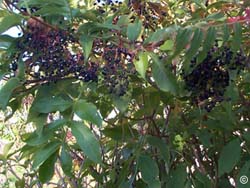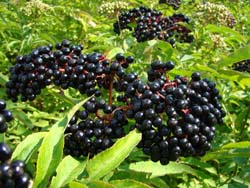What are elderberries good for?
Elderberries are native shrubs that produce fruit used in pies and wine. The fruit is seedy and tart, but high in vitamin C. These shrubs also are used for landscaping and wildlife habitat. Their leaves are opposite and compound with five to eleven leaflets, similar to green and white ash trees. The leaves also have serrated margins.

How big do Elderberry bushes grow?
Elderberries are upright, spreading shrubs that grow six to twelve feet high. Their showy, white flower-clusters generally are six-to-ten inches in diameter and have a pleasant fragrance. The fruit is a smooth globular berry that measures three-sixteenths of an inch in diameter.
What do Elderberries look like?
The broad, flat clusters of berries, which ripen in early August to late September, are deep purple to black. Some elderberries are partially self-fruitful and generally show increased fruit-set when two or more cultivars are planted in close proximity. Many birds and mammals feed on the fruit.
Are Elderberries a hardy bush?
Elderberries are drought and cold tolerant. They also tolerate almost any moisture condition and soil type. They grow at a pH of 5.5 to 7.5, but  prefer a pH of 5.5 to 6.5.
prefer a pH of 5.5 to 6.5.
Should I take any precautions when cultivating?
It’s important to cultivate around these shrubs carefully, because the root system is shallow and can easily be damaged. Elderberries have few pests, and natural predators often control any outbreaks.
Where should I plant elderberries?
Plant elderberries five to seven feet on center to accommodate good air circulation. Plant bare root stock or rooted cuttings in early spring and container-grown plants anytime during the growing season.



